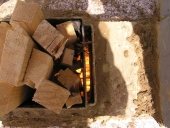I have tried this secondary air technique almost exactly how you drew it out but with a small variation. the issue with your drawing is:
1 your drawing is using cold air... that will cool your fire and you need heat.
2 your drawing is adding additional air to the system than designed and will act like a "leak" and slow suction down.
my exact idea consisted of running a steel tube along the bottom from the front of my access port to the back of the J tunnel up and i moved it back and forth to try and get the proper spot of additional air to the burn tunnel flame.
My results unfortunately i only documented them in in person and did not record them, sorry: my results found that the additional air in any part of the burn tunnel did not increase temperature and in fact decreased the draw and temp significantly. i did not try different sizes of air tube and maybe that could be done. my air tube was about an inch in ID.
Color and Temperature of my fire described: its hard to capture in a youtube video what the naked eye can see but the flame is very bright and dazzling with fine blue edges and you can see it at the end of this video when i get real close you can see im trying to focus in on the fire brick in the burn tunnel that is glowing orange/red. the camera goes into the front of the access port where the cold air is designed to pull through and feed my RMH with lots of air to draw into the burn cahmber and that is the exact location i placed my air tube going to the back of the burn tunnel.
Most of our RMH are getting to freaky temps and are getting everything they need or they wouldnt operate the way they do. my RMH heater is getting so hot the bricks are glowing and my flames edges are turning blue with a bright dazzling inferno. when your flames are turning blue it means you have reached about max flame temp you can do. if there is a hotter color temp than blue i do not know about it.
The temperature range from Red to White:
Red
Just visible: 525 °C (980 °F)
Dull: 700 °C (1,300 °F)
Cherry, dull: 800 °C (1,500 °F)
Cherry, full: 900 °C (1,700 °F)
Cherry, clear: 1,000 °C (1,800 °F)
Orange
Deep: 1,100 °C (2,000 °F)
Clear: 1,200 °C (2,200 °F)
White
Whitish: 1,300 °C (2,400 °F)
Bright: 1,400 °C (2,600 °F)
Dazzling: 1,500 °C (2,700 °F)
According to the info above (source: Wikipedia) the difference between red-hot and white-hot is about 1000 degrees. But what about blue-hot?
Anytime you see blue in a fire it is hotter than white. The range is between 2,600 and 3,000 degrees Fahrenheit and its the most oxygen-rich type of flame. A bunsen burner is a good example:
Bunsen burner flames:
1) air hole closed
2) air hole slightly open
3) air hole half open
4) air hole almost fully open (this is the roaring blue flame).
Bunsen burners use a mixture of gases. Gas burns hotter than organic materials such as wood and straw. Natural gas stove flames are blue. Propane flames are blue with yellow tips. The hottest fires are from oxyacetylene torches (about 3000 degrees Centigrade) that combine oxygen and gas to create pinpoint blue flames.





 2
2




 1
1










 1
1




 1
1




















 1
1




 Big AL
Big AL 



 . He has done over 200 hours of burns on some of his stainless steel parts!
. He has done over 200 hours of burns on some of his stainless steel parts!












 are you planning/designing a build?
are you planning/designing a build?
 1
1













